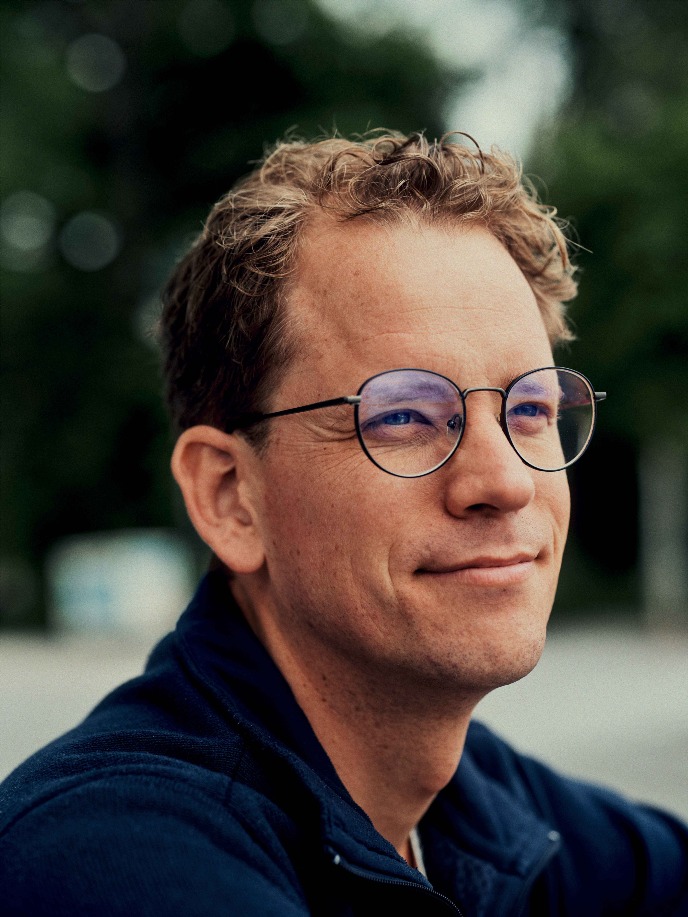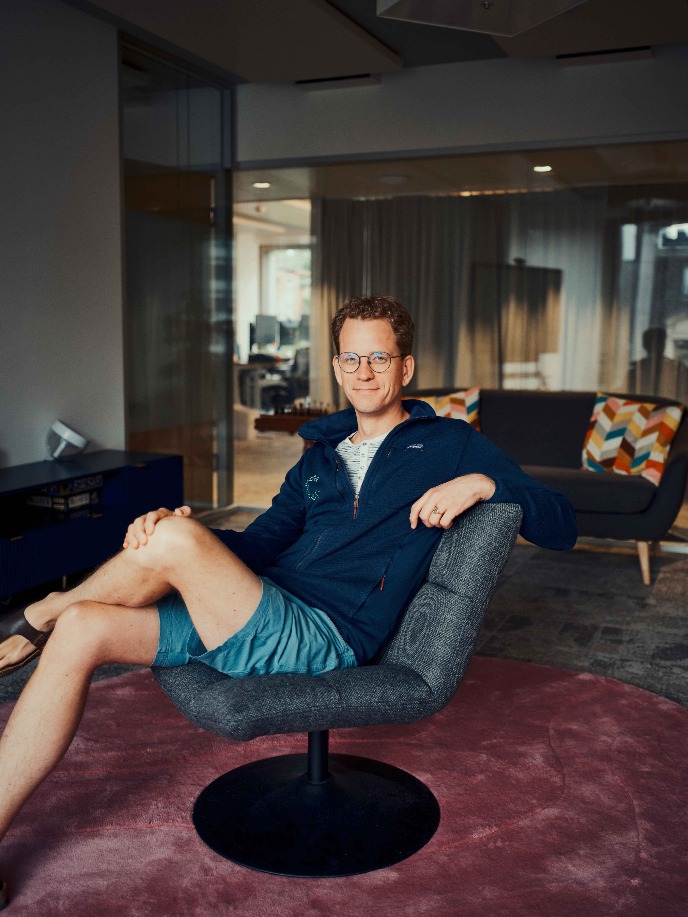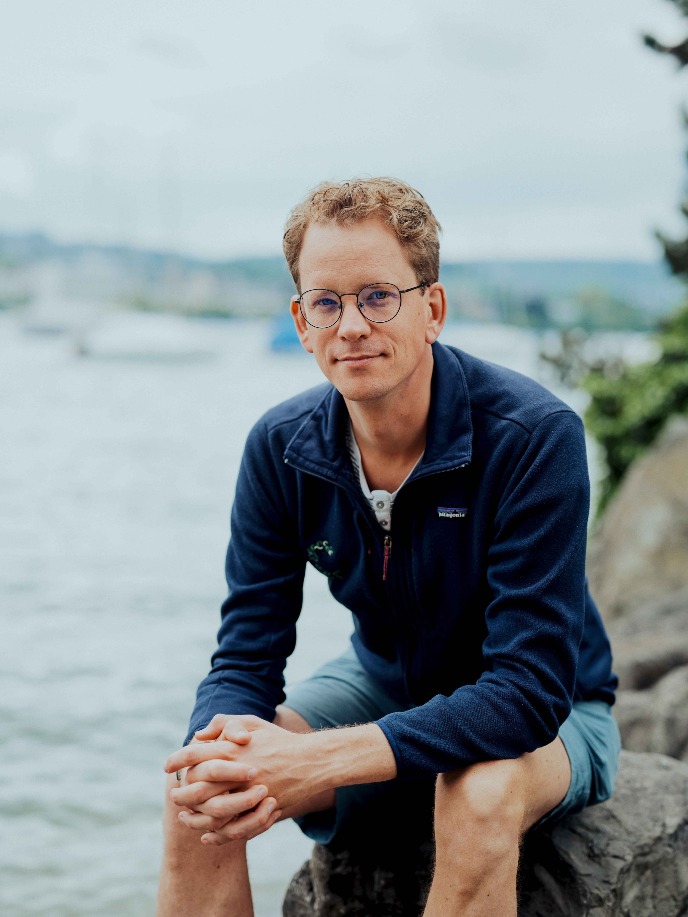Developing proteins with a language model

Stef van Grieken is the new UG Alumnus of the Year. In 2021, he founded a company, Cradle, that deploys Artificial Intelligence (AI) to design better proteins. In less than two years, the first multinationals were already knocking on his door. ‘In 20 years’ time, I want to be able to say: I used my knowledge and expertise to do the right thing.’
Text: Nienke Beintema / Photography: Joël Hunn ©
What do you do when you are, in your own words, a ‘science nerd’, brimming with ideas, with a deep understanding of AI and a longing to make the world a better place? Well, you invent a version of ChatGPT that does not write texts on command, but instead designs proteins, based on the wishes and requirements of pharmaceutical and biotech companies. And then you give up a golden career at Google to start your own company, which immediately becomes a success. Stef van Grieken shows how it can be done. It is precisely this combination of intelligence, entrepreneurship, and social commitment that recently led the UG to nominate him as Alumnus of the Year 2024. ‘I find it super cool,’ says the young entrepreneur in a video call from his home in Zurich. ‘I have always been a huge fan of the University of Groningen. During my studies, I was active in student politics, and even after my studies, I continued to feel involved. When your alma mater then awards you such an honorary title, it is really great.’
Why do you live in Zurich, actually?
‘I worked for Google in the US for a long time, with great pleasure. But then I was offered a position at the Google office in Zurich, the big European tech hub. I seized the opportunity because I no longer liked the way things were going in the US. And the research team here was good. But I still decided to quit to start my own company, Cradle. I wanted to keep living in Zurich, though: life is good here, and it's a great ecosystem for life sciences: there is a university, lots of expertise in self-learning models, a beautiful environment... And I can easily take the tram to Amsterdam, where our company has a a second branch. So yes, it is perfect this way.’
You studied Industrial Engineering and Management. How did you end up working with AI?
‘Within my degree programme, I followed the technical path and opted for the computing science track. But alongside that, I had been programming since I was a child. Cradle is kind of a hobby that has gotten out of hand.’
In the midst of all this, you somehow also studied Philosophy.
‘Yes, I did that alongside my degree programme because I find it extremely valuable. Many engineers are really good at making things, but you have to keep asking yourself: is this something we should want? And if the answer is yes, how can we do it in a responsible way? That is not self-evident, not even in Silicon Valley—where new things are being invented that will affect a lot of people. It is really important that we continue to ask critical questions in the process. Incidentally, I did not complete that Bachelor's degree, although I hope I will one day.’

This ethical stance of yours, does it actually fit in a company like Google?
‘I am glad you asked. You know, all this finger-pointing in Europe at companies like Google, I honestly do not think it is justified. Take, for example, the impact of search engines on science. Without search engines, that landscape would look completely different, and people would never be able to get so much information together so quickly, be able to collaborate so much, and therefore be able to do so many important things. That alone makes the development of search engines worthwhile. Real impact in the world can only be achieved by expanding knowledge and giving people access to it. That is what those companies do. And a company like Google also invests a lot of time in trust and the safety of their products.’
Why did you decide to switch to protein design?
‘Google is very deep into language models, with all the searching, translating, chatting... I thought: how can we use this to tackle the real problems that the world is facing? Basically, these problems come down to this: we have pretty much set the planet on fire, and we are running up against the limits of the healthcare system, with more and more elderly and sick people. I thought, if I want to be able to look my daughter in the eye in 20 years’ time, that is what I need to devote my knowledge and skills to now. I want to be able to say: I really tried to do the right thing.’
How did you come up with the idea of having a language model design proteins?
‘A language model has basically learned how a language works. What is the set of words that make up that language? And which words fit together in what order? Proteins are also made up of building blocks: amino acids. Their composition and sequence determine what a protein does. Sometimes a single amino acid already makes a difference. Playing with this is something you can ask a model to do. The only difference is that with language, we intuitively have some sense of what is right. What types of words can or cannot follow each other, for example. We don't have that with proteins. We don't automatically know what is functional.’

So how do you go about it?
‘Basically, you want to design a protein that does what biotechnologists want. For example, a protein that binds to something or not, that reacts with something, or that is stable at a temperature of 45 degrees. So you start with a self-learning model, and you teach it what type of protein has which properties. Models are very good at learning these kinds of rules or laws. With language, but apparently also with proteins.’
Really? So this actually works?
‘Yes, several of our customers, including Johnson & Johnson, have already used our model to successfully modify proteins to make them more effective. One customer initially needed ten rounds to make a particular enzyme eight times more active. Now the enzyme can be made 24 times more active in just three rounds. It is more targeted, which means it is faster and cheaper, so you can do more as a company. That is the bottom line.’
Is this already really applicable?
‘Certainly! A number of successful enzymes have already been produced that are being used in the industry. With medicines, it is a bit trickier, as the average clinical trial takes longer than Cradle has been around. But it will all work out. In the meantime, we continue to work on our model. With the initial funding round of $5 million, we were able to show that language models can be used to make proteins. We recently secured $24 million from investors to develop this further.’
Is this really going to change the pharmaceutical and biotech industry?
‘I definitely think so. Imagine if R&D in life sciences could be ten times faster... Then a lot more companies could do many more things. It is a kind of democratization of organic chemistry. And there are so many more applications, such as better bioplastics, biofuels, biological crop protection... Using agricultural crops to fix nitrogen, making milk proteins with a machine, rather than a cow... We call it “building with biology”. I really think that a lot of fantastic things are going to happen. And really already within 10 to 15 years, mind you. I have no doubt about it.’
Curriculum vitae
Stef van Grieken (1986) studied Industrial Engineering and Management at the UG. Already during his studies, he founded the Open State Foundation, which aims to make government more transparent. He then worked for seven years as a technical manager at Google. In 2021, together with a colleague from Google and two biologists, he launched Cradle, a company that develops a platform for innovative protein design via Artificial Intelligence (AI). CEO Van Grieken lives and works in Switzerland.
This article has been taken from our alumni magazine Broerstraat 5.
More news
-
15 September 2025
Successful visit to the UG by Rector of Institut Teknologi Bandung
